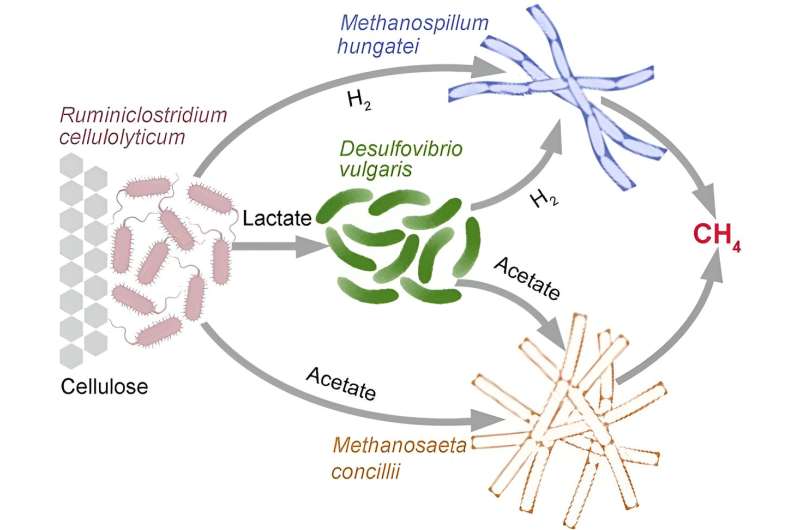This article has been reviewed according to Science X's editorial process and policies. Editors have highlighted the following attributes while ensuring the content's credibility:
fact-checked
peer-reviewed publication
trusted source
proofread
To study competition and cross-feeding, scientists build synthetic microbiomes

In nature, microbes exist in complex relationships with large numbers of other microbial species in communities called microbiomes. The complexity of these microbiomes makes it difficult for scientists to study and predict microbes' interactions. That's why scientists use custom assemblies of microbes called synthetic communities to closely study microbial feedbacks, such as competition and cross-feeding. Cross-feeding involves microbes producing nutrients that other microbes in the environment use and vice versa.
In this study, scientists designed a four-member community involved in the breakdown of cellulose into the greenhouse gases methane and carbon dioxide. The researchers then constructed a mathematical model to represent the transfer of carbon and electrons throughout the community metabolic network.
Next, they used this model to infer how microbes respond to increases in sulfate. Rising sea levels due to climate change may increase the amount of sulfates in coastal wetlands and aquifers. This could affect the role of microbes in the carbon cycle. The findings are published in the journal mBio.
As organisms interact with each other, it can lead to new properties that aren't found in the individual organisms themselves. These emergent properties can be hard to predict.
To overcome this challenge, researchers use synthetic microbial communities. These communities are simplifications of real-world communities with a smaller number of microbes than found in natural communities. They are designed to show the role different individuals play in a community's metabolism—how it uses and creates energy. This allows researchers to confirm their predictions for metabolic exchanges and interactions, both positive and negative, in natural systems.
Using synthetic communities also allows scientists to quantify how microbes interact. Scientists then use this information to build better models of natural processes. This knowledge might also help researchers improve how microbes interact to produce bioproducts.
Synthetic microbial communities are a powerful tool to study microbial interactions. However, most studies to date have focused on binary interactions between only two microbial species to describe their interactions and were constrained by individual methods.
This study investigated complex interactions among four cross-feeding microorganisms in a synthetic community (SynCom) that converts cellulose to methane and carbon dioxide. The researchers used the SynCom as a model system for studying the biochemical and physiological responses and function changes of microbial community behavior in estuarine wetlands under the threat of seawater intrusion.
Scientists expect sea level rise will bring greater levels of seawater intrusion into coastal wetlands and aquifers. The inclusion of a sulfate-reducing bacterium in the synthetic community enabled the researchers to examine the impact of sulfate intrusion on community dynamics.
The researchers characterized the biochemical and physiological responses of each microorganism in the synthetic community via proteomic analysis to study their ecological and metabolic responses and to model the inter-species interactions governing carbon exchange.
Stoichiometric modeling indicated that sulfate addition changed carbon and electron fluxes, as well as metabolic interactions, in predicted ways, but also revealed positive and negative synergies as emergent properties of high-order microbial interactions. This study paves the way toward a more predictive understanding of the impact of environmental perturbations on microbial interactions sustaining geochemically significant processes in natural systems.
More information: Dongyu Wang et al, Cross-Feedings, Competition, and Positive and Negative Synergies in a Four-Species Synthetic Community for Anaerobic Degradation of Cellulose to Methane, mBio (2023). DOI: 10.1128/mbio.03189-22
Journal information: mBio
Provided by US Department of Energy


















